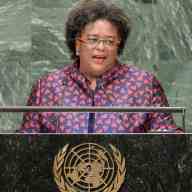UNITED NATIONS, Sep. 22, 2010 – As a three-day anti-poverty talkfest drew to a close Wednesday, the United Nations shifted its focus from the poor and the hungry to two of the most vulnerable and disadvantaged groups in society: women and children.
The mission: a “massive drive” to save the lives of more than 16 million women and children dying of deadly diseases every year, primarily due to the lack of basic medical care.
The means: pledges and commitments of over 40 billion dollars in funding over the next five years from over 35 governments, 15 charitable institutions, seven U.N. agencies, 13 private corporations and more than 50 non- governmental organizations (NGOs).
U.S. Secretary of State Hillary Clinton described the joint program as “a remarkable effort” by Secretary-General Ban Ki-moon to help developing nations meet two of the eight Millennium Development Goals (MDGs): reducing by two-thirds the mortality rate of children under the age of five, and slashing maternal mortality rates by three-quarters.
The developing world, which is most devastated by these deaths, has a five-year 2015 deadline to meet the two goals.
The secretary-general said an estimated 26-42 billion dollars will be required annually during 2011-2015 to meet the global targets on women’s and children’s health.
As he launched the ‘Global Strategy for Women’s and Children’s Health,’ Ban said: “The 21st century must be and will be different for every woman and every child.”
“We know what works to save women’s and children’s lives, and we know that women and children are critical to all of the MDGs”, he noted.
Thoraya Ahmed Obaid, executive director of the U.N. Population Fund (UNFPA), told IPS that “women who die are just the tip of the iceberg”.
Every year, she said, millions of women suffer injuries related to pregnancy and childbirth. One of the most severe is fistula: a devastating birth injury that often leaves women ostracised by their families and communities.
“We need more action. We have to strengthen health systems so they can deliver for women, when women are ready to deliver,” she added.
Obaid said the MDG lagging the most is the one on maternal health (MDG 5), which aims to reduce maternal deaths and ensure universal access to reproductive health by 2015.















